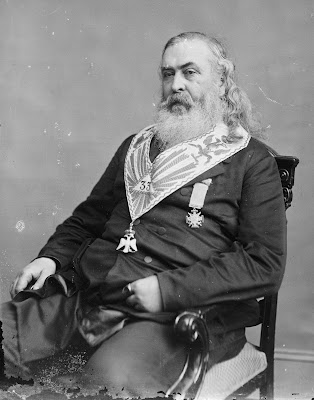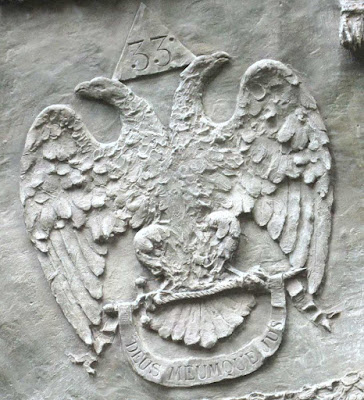If we’re going to be toppling statues of Confederates, it’s good to remember there’s one Confederate general with a statue in Washington, D.C. It’s located near the Judiciary Square stop on the Metro, and, as I recall when I visited in 2014, is very close to D.C.’s city hall and court house. You know, D.C. — a city that until very recently had a majority black population and where residents have no voting representation in Congress.
The statue, unfortunately, sits on Federal land and is maintained by the National Park Service. So the residents of the city have no say in its existence, as is true of so many inequities in D.C.

The Latin words “Vixit Laborum Ejus Super Stites Sunt Fructus,” which translate to “He has lived. The fruits of his labors live after him,” are inscribed below the feet of the female figure.
The man at the top of that pile of stone is Albert Pike, who was, as the base tells us in words carved on all four sides, an Author, Poet, Orator, Jurist, Philanthropist, Philosopher, Soldier, Scholar. Most importantly for the reason it was erected, though, he was also a prominent Mason. And possibly one of the founders of the Ku Klux Klan. A few years after I took these photos, his list of titles had some spray-painted words added to it: Black Lives Matter.
Born in the Boston area in 1809, Pike left New England at 22 and went to New Mexico, then Arkansas. He married there and ran a newspaper. As he and his wife were in the midst of having 10 children, he studied law and took the bar at 28. They moved to other southern cities over time, including Charleston, South Carolina. Pike was part of the Know-Nothing Party in the late 1840s, but — according to the Washington Post — “left when he found the party’s support of slavery insufficiently intense.”
He became a Mason in 1850, at age 41, in Arkansas. The state's main Masonic building, in Little Rock, is named for him.
Pike was 52 at the start of the Civil War and was made a general, overseeing Confederate relations with six Native American nations. It sounds like he had no talent for command, though, and deserted (or resigned?) after losing a battle where he led native fighters and lost. He was charged with treason by the Confederacy and then later by the Union. Luckily, Andrew Johnson was also a Mason, so he pardoned Pike.

Not long after the war, he was editing the Memphis Appeal (today known as the Commercial Appeal). As the Post writer puts it, “It is during this time that he is alleged to have fallen in with the nascent Ku Klux Klan. The first ‘Wizard,’ former Confederate General Nathan Bedford Forrest, traveled the region drumming up support for his organization. Among those so drummed, some say, was Albert Pike. Whether he did in fact join the Klan is no simple question.”
According to the Post, “Even if Pike wasn’t involved with the Klan, he did believe that the races should not mix. He was against integrating Masonic lodges.”
But here’s something Pike wrote for an editorial in the Appeal, April 16, 1868:
With negroes for witnesses and jurors, the administration of justice becomes a blasphemous mockery. A Loyal League of negroes can cause any white man to be arrested, and can prove any charges it chooses to have made against him. ...The disenfranchised people of the South...can find no protection for property, liberty or life, except in secret association.... We would unite every white man in the South, who is opposed to negro suffrage, into one great Order of Southern Brotherhood, with an organization complete, active, vigorous, in which a few should execute the concentrated will of all, and whose very existence should be concealed from all but its members. (source; this site includes other evidence that Pike was indeed a Klan founder)Pike moved to Washington, D.C. in 1870 at age 61. He wrote a book called Morals and Dogma that is unreadable, most say, but is or was beloved by the Masons enough that they raised money for this statue within 10 years of his death in 1891. Even though they have their own bust of him in their Scottish Rite temple along 16th Street NW, where the library is also named for him. They really, really liked him.
I think Pike has enough memorializing for one man in his multiple Masonic locations. We don't need a public memorial on a street in Washington, D.C. Time for it to come down.


Pike was over 6’ tall and more than 300 pounds, with waist-length hair, it's said, though it doesn't look quite that long in this photograph.

The double-headed eagle on the banner held by the female figure clutches the words "Deus Meumque Jus," which mean "God and my right" or "God and my moral rightness," a common Masonic phrase.
___
Details in this post come from the Traveling Templar (a Masonic site, which insists Pike had nothing to do with the Klan), the DCist, and a 2016 article from the Washington Post.


No comments:
Post a Comment